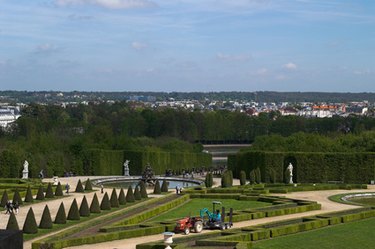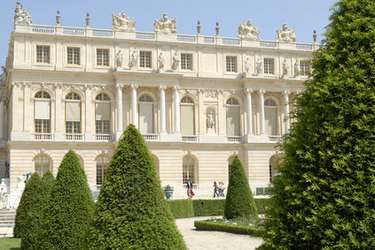
Versailles, built just outside Paris in the 17th century, is one of the best-known French castles. The palace itself is designed with elaborate architecture and attention to detail, but for many it's the gardens at Versailles that are worth visiting. The 250-acre gardens are filled with plants, fountains, paths and statues. The plants in the gardens at Versailles are colorful and well-tended. Use some of the same plants in your garden and enjoy their luxury at home.
Hedges
Video of the Day

Hornbeam hedges, clipped and trimmed to perfection, are used as ornamentals and screens throughout the gardens at Versailles. Hornbeam (Carpinus betulus) is classified as a deciduous plant, but most of the leaves remain on the hedge even through the winter. Hornbeam grows well even in heavy, clay-rich soil, making it a very hardy, tolerant plant.
Video of the Day
Before planting hornbeams, you must place a support system everywhere the hedges will be grown. Plant hornbeam hedges in the late fall, either in late November or early December. Prune hornbeams to the shape you desire, using wires and support posts to train the hedges for height and width.
Trees

Many different trees grow in the gardens at Versailles. The garden features a tall Corsican pine, which was planted when Napoleon ruled as France's Emperor. Corsican pine is also called black pine. The tree is known for its straight, knot-free wood and twisting needles.
Visitors to Versailles will also find beech, poplar, chestnut and hawthorn trees in the gardens. The combination of trees is used to prevent the spread of disease.
Flowers
Each year, 50,000 flowers are planted in the gardens at Versailles to fill the acreage with bright color. Tuberoses, jasmine and pinks are three of the varieties you will notice along the garden beds.
Tuberoses grow well in hot summers, so northern gardeners should grow their plants in pots until they may be safely transplanted. Keep the soil moist, and fertilize the plants once or twice a year for optimal growth. Pinks are flowers in the dianthus plant family, which includes carnations. As with carnations, pinks should be planted in well-drained soil where they will receive approximately five hours of sunlight per day. Avoid over-watering pinks, which will make them turn yellow in color. Jasmine grows easily with little maintenance. Simply plant the flower and prune it regularly to keep it from spreading too far.
- Garden Visit: Versailles Garden
- Earth Sky: The Gardens of Versailles Go Green
- Smithsonian Magazine: Renaissance of the Gardens of Versailles
- The Independent: Like a Nice Tall Border for Your Garden? Pleached Hornbeam Is the Way to Go
- Introduced Species in the British Isles: Corsican Pine
- Versailles: Gardens and Park of the Château
- National Geographic Magazine: Top 10 Gardens
- The Washington Post: In the Gardens of Versailles, A Horticultural Revolution
- The Garden Helper: How to Grow and Care for Carnations, Pinks and Sweet Williams
- Country Living: Growing Star Jasmine